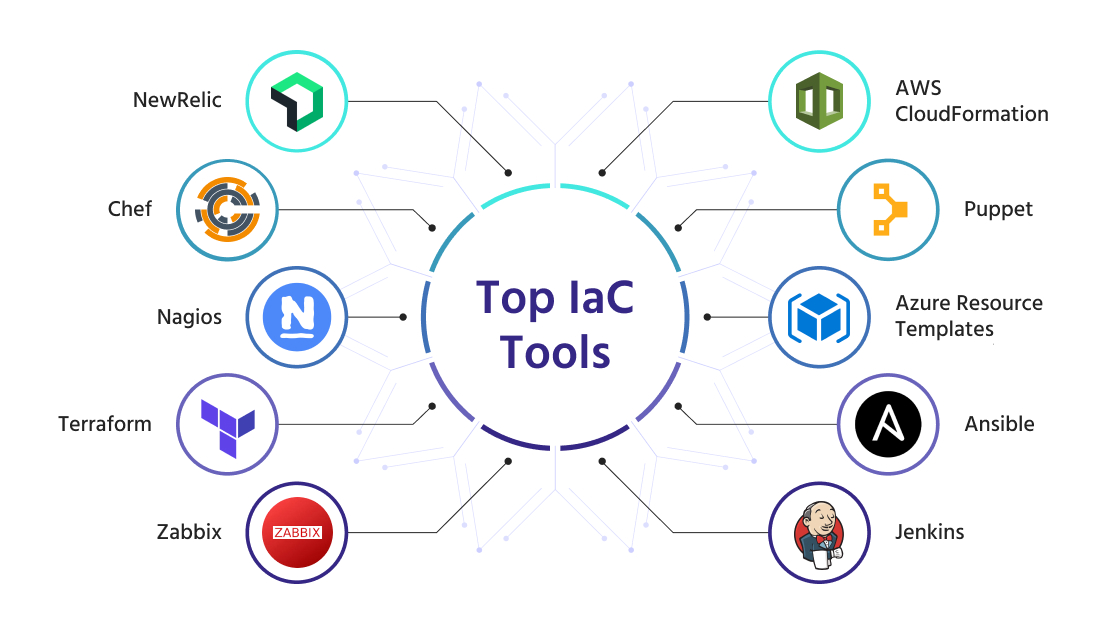What Is Infrastructure as Code (IaC)? How It Works and Tools To Use
When software developers take on a new project, it doesn’t mean that they start building it right away. Before getting down to coding, they should arrange an entire software development infrastructure first. Handling each piece of software manually as well as putting up servers in place and configuring them can turn into a real nightmare. Therefore, many software developers abandon the idea of manual management turning to more effective infrastructure management approaches. One of them is Infrastructure as Code. In this article, we’ll dive into the details of Infrastructure as Code (IaC). You’ll learn the basics of IaC and find out when it’s best to use IaC in custom software development.
What Is IaC?
Infrastructure as Code (IaC) is a DevOps approach when infrastructure is configured through code. It means that to set up a software development infrastructure, tech specialists use programming scripts that automate the configuring processes. With IaC, software developers obtain an automatically manageable system that is simple to monitor and provide the needed development resources.
So, what does Infrastructure as Code mean for the software development process, and why do so many developers prefer using IaC to manual infrastructure management?
The main IaC benefits include:
- Cost-efficiency – IaC processes are largely automated which means that companies don’t have to hire many specialists to set up, launch, monitor, and maintain the infrastructure.
- Speed – with IaC, IT specialists can quickly establish all the necessary processes thanks to well-adjusted DevOps practices and automation.
- Availability and scalability – with carefully tuned configuring, system administrators can rest easy at times of spikes in access as the system will simply scale up with the growing user traffic.
- Consistency – as the configurations for various software and hardware is provided in the form of a code, software developers can rest assured that all of the configs are consistent and applied evenly throughout the infrastructure.
IaC is one of the main DevOps practices and is a component of continuous delivery. This approach offers teams an established set of practices and tools that facilitates product delivery and its infrastructure support rapidly and consistently.
How Does IaC Work?
When building a project infrastructure, software developers realize that there is no one-size-fits-all. Therefore, they have to establish a new infrastructure with its own working specifics and a set of tools each time they start a new project. Nevertheless, there are some key features that can be traced in different infrastructures. For example, all infrastructures can be characterized by:
- Approach – imperative and declarative.
- Ability to change infrastructure components – mutable and immutable.
Let’s have a closer look at each category.
Imperative approach. With an Imperative approach, IT specialists define the steps/commands they should take/use to implement any changes to the infrastructure. This approach mostly relies on object-oriented languages, e.g. Java, C++, and others used for imperative programming.
Declarative approach. In the Declarative approach, DevOps professionals outline the desired result and the tools and platforms that take action to reach it. SQL and AWS CouldFormation templates are among the examples of declarative programming.

For both approaches, IT specialists configure IaC on a template where they outline all the resources that should be used for setting up each server in the infrastructure. The templates are super useful as they ensure that the infrastructure is properly set by putting it in the appropriate setup. DevOps specialists can layer templates by organizing resources in a stack, and making the system clear and coherent.
Mutable infrastructure. It’s the infrastructure that is composed of separate components united together. Changing one component during the development process won’t affect the infrastructure nor overall service, meaning that the application will work as normal.
Immutable infrastructure. This is a type of infrastructure where software developers have to consider all the components in advance. It’s a solid structure of components and resources that can’t be changed or reconfigured later on. Therefore, changing one component will require the entire system to be updated and redeployed.
When & How to Use Infrastructure as Code
Infrastructure setup is a mandatory process for building effective and reliable applications. Software developers can facilitate this process by opting for IaC infrastructure configuring approach. With IaC, they can easily scale up/down their infrastructure and quickly restore it after system failures.
IaC ensures the system’s safety from failure, configuring consistency, quick and pain-free infrastructure deployment, and much more. Therefore, anyone who is interested in building solid, reliable, and performant software can use IaC on their projects.
Infrastructure as Code Tools
The IaC approach involves a great diversity of tools used for infrastructure and configuration management. These tools can be open-source or specific for a certain platform.

While there is a wide range to choose from, at Scand we offer our clients the most reliable and time-tested tools and platforms to ensure stable and performant work of the infrastructures we set up. Some of these tools are listed below.
Infrastructure management tools
- Terraform is one of the prominent IaC tools aimed at infrastructure management across various Cloud platforms, including AWS, Azure, GCP, Oracle Cloud, and others. It helps to facilitate infrastructure provisioning and use case management on various platforms.
- Ansible is a simple but performant tool used for task automation on various platforms. With Ansible, IT specialists can manage configurations, deploy applications, orchestrate services, update servers, and do much more.
- Chef/Puppet are powerful tools for the configuration of enterprise-level infrastructures. Chef is an automation platform for easy configuring, deploying, and managing infrastructures. The Puppet is similar to Chef. It’s an open-source tool for centralizing and automating configuration management. Both tools are great for automating and configuring infrastructure through code.
- AWS CloudFormation is an AWS service aimed at modeling and setting up AWS resources for the effective management of AWS infrastructure. AWS CloudFormation allows creating of various templates with configs for service or application architectures and handling them in simple-to-update or replicate stacks.
- Azure Resource Templates are JSON-based resource templates that support IaC for simple Azure platform management. DevOps teams can create templates with any type of resource configuration for any project. The templates support declarative syntax, making it easy to quickly deploy them without writing sequences of programming commands.
Monitoring tools
- Zabbix is an enterprise-level open-source solution for monitoring networks, servers, virtual machines, cloud services, and applications. It consolidates multiple metrics from network utilization to CPU load, to disk space consumption, and more.
- Nagios is a monitoring tool for networks, systems, and infrastructures. Apart from monitoring, it also provides alerting services for servers, applications, services, and many others.
- Graphite is another monitoring tool that graphs various metrics, e.g. computer system performance, infrastructure performance, network throughput and latency, and much more.
- NewRelic is a performance tracking and data analysis tool. It brings data from various sources, be it Cloud platforms, frameworks, or stand-alone applications and tools. It analyzes data from various metrics, events, or logs, and provides the results in visual dashboards.
Conclusion
Infrastructure as a code is a popular approach used for building modern software solutions. It alleviates the infrastructure configuring and management processes, making infrastructures much faster to set up and easier to scale while preserving consistency over the whole system. IaC forms the basis of successful software development.
Those companies that consider implementing IaC on their project will require a small team of DevOps specialists. They will transform all the configurations into code and implement them across the system. Our DevOps team has implemented the IaC approach in their work and have successfully established infrastructure environments for various software development projects. If you have any doubts about your infrastructure, don’t hesitate to contact us.












